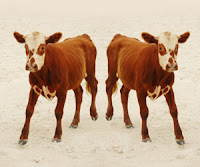I remember looking at the rear view mirror of the car, looking straight into the enormous eyes and huge face of that dinosaur. It freaked me out as I saw the dinosaur move closer towards the car. The words printed on the mirror were-
'objects in the mirror are closer than they appear.' I wondered, "wasn't it dangerously close enough already?"
Nothing to worry, I really didn't get lost in the dinosaur age! I was just recalling my feelings when I watched this scene from the movie
'Jurassic Park', a movie about cloned dinosaurs among the human race.
 |
| A still from Jurassic Park movie (Courtesy:unrealitymag.com) |
The movie was a fictitious one but today, it seems that it inspired reality. It looks like, it set the scientific imagination running as scientists explored the possibility of cloning extinct animals.
Wendee Holtcamp, in her blog, Cloning the Mammoth? (from Animals in the News) analysed the possible impact of cloning the woolly mammoth.Progress in science has made it possible to extract the undamaged genetic material and re-creating the woolly mammoth.After all, if living animals have been cloned, extinct animals could be cloned too (as their DNA information is within access).
Wendee, in her blog stated:
"Bringing back a species that is long since extinct, like the woolly mammoth, is surely more ecologically problematic than attempts to restore presently endangered species, or recently extinct species...if one does successfully clone the mammoth, where will it go? We could put the mammoth in a zoo or a pen, and study it like a lab rat. And that’s probably what would happen. Is that ethical?"
 |
| Could mammoths adjust from the Ice Age to the Global Warming Age? (Courtesy: fraekingnews.com) |
I agree with Wendee.
Although bringing alive the extinct animals sounds fantastic and would be a breakthrough in science, the matter raises several issues.
Animals like the dinosaurs and woolly mammoths existed several thousand centuries ago.
Climatic conditions were completely different then. There were different sorts of living were roaming the Earth then and there was a certain cycle of nature operating that made it possible for each of the species to survive. With time, that cycle broke to make for a new one, then another one and another one.
Wouldn't re-introducing extinct species into today's cycle of nature be problematic for all species and lead to problems of adaptation? Besides, there are problems of adjusting with their dietary requirements and temperaments that Wendee talks of.
 |
| Cloned sheep (Courtesy:grtu.net) |
Cloning itself is problematic even when it comes to cloning living species. Animals like sheep, goats, cows, etc have been cloned succesfully, but they usually died soon due to weak health in comparison to their non-cloned counterparts. In that case, how risky would it be to clone extinct species?
The Earth today is over-crowded. Everybody is clamouring for space to make way for the rapidly increasing population entering into billions. As a result, natural habitats are getting destroyed and animals are dying out due to lack of space. I fail to understand, how we could accommodate gigantic animals under such conditions.
On a personal and simplistic level, if computerized, graphic dinosaurs on the large screen could have a scary impact on you, how would it be like to face the real versions right from your window?
It is commendable that science has advanced so much and keeps expanding its own possibilities. But wouldn't it make more sense if technology is invested more on the living and endangered species on Earth and ensuring their survival, rather than bringing back more species from the dead?






















 squidoo.com
squidoo.com












